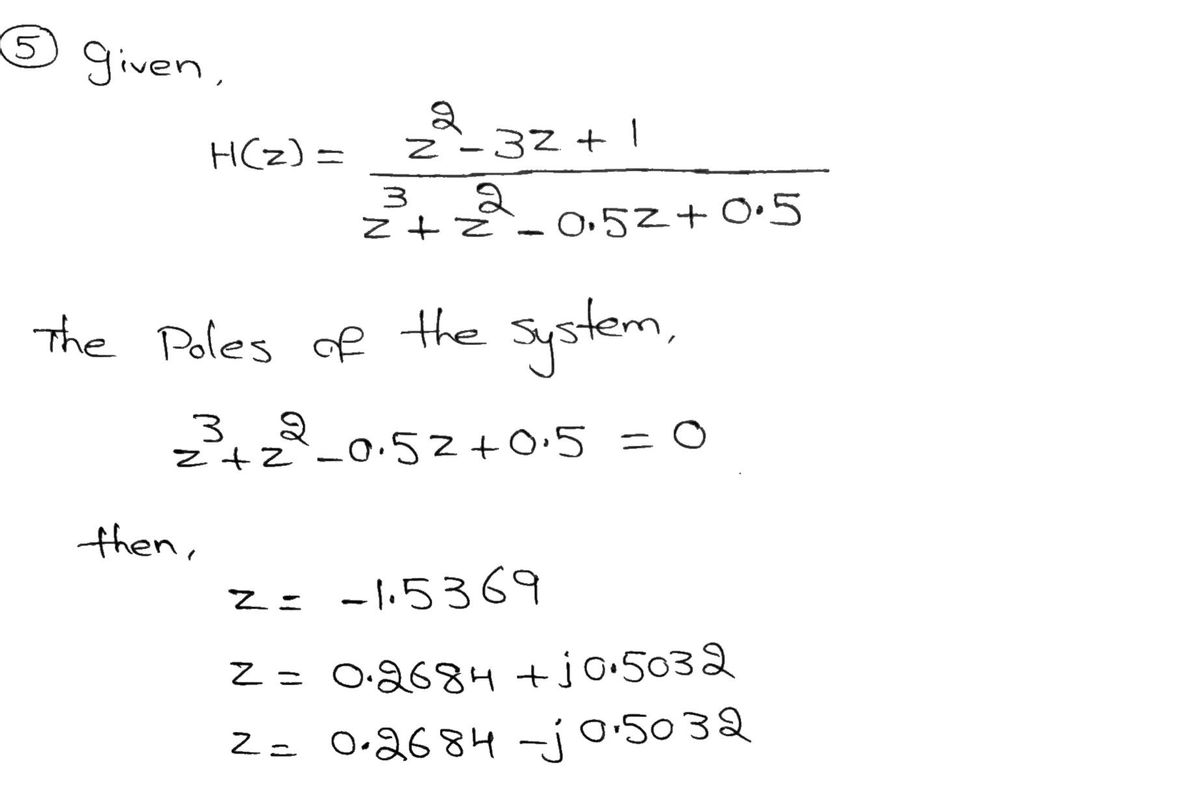Is the system stable, marginally stable, or unstable
Introductory Circuit Analysis (13th Edition)
13th Edition
ISBN:9780133923605
Author:Robert L. Boylestad
Publisher:Robert L. Boylestad
Chapter1: Introduction
Section: Chapter Questions
Problem 1P: Visit your local library (at school or home) and describe the extent to which it provides literature...
Related questions
Question
100%
![**Problem 5: System Stability Analysis**
A system has the transfer function:
\[ H(z) = \frac{z^2 - 3z + 1}{z^3 + z^2 - 0.5z + 0.5} \]
**Question:**
Is the system stable, marginally stable, or unstable?
**Analysis Guide:**
To determine the stability of a system based on its transfer function, consider the following general guidelines:
1. **Stability Criterion:**
- For a discrete system, evaluate the locations of the poles of the transfer function \( H(z) \).
- The system is stable if all poles lie inside the unit circle in the complex plane.
2. **Poles and Zeros:**
- Poles: The values of \( z \) that make the denominator zero.
- Zeros: The values of \( z \) that make the numerator zero.
3. **Steps to Assess Stability:**
- Factor the denominator to find the poles.
- Check the magnitude of each pole. All poles must have a magnitude less than 1 for the system to be stable.
By following these procedures, you can determine if the system is stable, marginally stable, or unstable.](/v2/_next/image?url=https%3A%2F%2Fcontent.bartleby.com%2Fqna-images%2Fquestion%2Fe2b6cedf-1de1-433d-8173-2409fffc8f05%2F07e7dda3-be62-484e-b60f-2bd2e7e8a976%2Fmyisa4r_processed.jpeg&w=3840&q=75)
Transcribed Image Text:**Problem 5: System Stability Analysis**
A system has the transfer function:
\[ H(z) = \frac{z^2 - 3z + 1}{z^3 + z^2 - 0.5z + 0.5} \]
**Question:**
Is the system stable, marginally stable, or unstable?
**Analysis Guide:**
To determine the stability of a system based on its transfer function, consider the following general guidelines:
1. **Stability Criterion:**
- For a discrete system, evaluate the locations of the poles of the transfer function \( H(z) \).
- The system is stable if all poles lie inside the unit circle in the complex plane.
2. **Poles and Zeros:**
- Poles: The values of \( z \) that make the denominator zero.
- Zeros: The values of \( z \) that make the numerator zero.
3. **Steps to Assess Stability:**
- Factor the denominator to find the poles.
- Check the magnitude of each pole. All poles must have a magnitude less than 1 for the system to be stable.
By following these procedures, you can determine if the system is stable, marginally stable, or unstable.
Expert Solution
Step 1

Step by step
Solved in 2 steps with 2 images

Knowledge Booster
Learn more about
Need a deep-dive on the concept behind this application? Look no further. Learn more about this topic, electrical-engineering and related others by exploring similar questions and additional content below.Recommended textbooks for you

Introductory Circuit Analysis (13th Edition)
Electrical Engineering
ISBN:
9780133923605
Author:
Robert L. Boylestad
Publisher:
PEARSON

Delmar's Standard Textbook Of Electricity
Electrical Engineering
ISBN:
9781337900348
Author:
Stephen L. Herman
Publisher:
Cengage Learning

Programmable Logic Controllers
Electrical Engineering
ISBN:
9780073373843
Author:
Frank D. Petruzella
Publisher:
McGraw-Hill Education

Introductory Circuit Analysis (13th Edition)
Electrical Engineering
ISBN:
9780133923605
Author:
Robert L. Boylestad
Publisher:
PEARSON

Delmar's Standard Textbook Of Electricity
Electrical Engineering
ISBN:
9781337900348
Author:
Stephen L. Herman
Publisher:
Cengage Learning

Programmable Logic Controllers
Electrical Engineering
ISBN:
9780073373843
Author:
Frank D. Petruzella
Publisher:
McGraw-Hill Education

Fundamentals of Electric Circuits
Electrical Engineering
ISBN:
9780078028229
Author:
Charles K Alexander, Matthew Sadiku
Publisher:
McGraw-Hill Education

Electric Circuits. (11th Edition)
Electrical Engineering
ISBN:
9780134746968
Author:
James W. Nilsson, Susan Riedel
Publisher:
PEARSON

Engineering Electromagnetics
Electrical Engineering
ISBN:
9780078028151
Author:
Hayt, William H. (william Hart), Jr, BUCK, John A.
Publisher:
Mcgraw-hill Education,